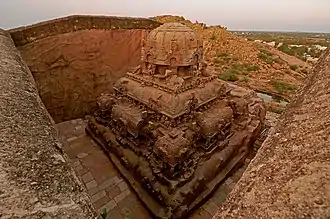Pandyan art and architecture
Rock cut and structural temples are significant part of Pandyan art and architecture. The vimana and mandapa are some of the features of the early Pandyan temples.[1] Groups of small temples are seen at Tiruchirappalli district of Tamil Nadu. The Shiva temples have a Nandi bull sculpture in front of the maha mandapa.[2] In the later stages of Pandyas rule, finely sculptured idols, gopurams on the vimanas were developed. Gopurams are the rectangular entrance and portals of the temples.[3][4]

Vettuvan Koil in Kalugumalai, Pandyan architecture, 8th century CE
History

Four-armed Vishnu, Pandya Dynasty, 8th–9th century CE.
Pandyan Temples
Kalugumalai Temple complex (768-800 CE)
Others
- Meenakshi Amman Temple
- Sittanavasal Cave - Rock cut cave and Paintings from 9th century Pandyan period
- Srivilliputhur Andal temple
- Ranganathaswamy Temple

Kalugumalai Jain Beds, Pandyan Empire, King Parantaka Nedunjadaiya (768-800 CE)
| Wikimedia Commons has media related to Art of the Pandyan Dynasty. |
References
- Desai, Pandurang Bhimarao (1971). Studies in Indian history and culture: volume presented to Dr. P. B. Desai ... on the occasion of his completing sixty years. Prof. P. B. Desai Felicitation Committee, Karnatak University; [for copies write to the printer: K. E. B's Print. Press]. p. 125.
- Rajan, K. V. Soundara (1 March 1998). Rock-cut temple styles: early Pandyan art and the Ellora shrines. Somaiya Publications. p. 58. ISBN 9788170392187.
- Allen, Margaret Prosser (1991). Ornament in Indian Architecture. University of Delaware Press. p. 350. ISBN 9780874133998.
- Mansingh, Surjit (9 May 2006). Historical Dictionary of India. Rowman & Littlefield. p. 430. ISBN 9780810865020.
- "Sthala Varalaru". Hindu Religious and Endowment Board, Government of Tamil Nadu. 2015. Archived from the original on 17 November 2015. Retrieved 4 November 2015.
This article is issued from Wikipedia. The text is licensed under Creative Commons - Attribution - Sharealike. Additional terms may apply for the media files.
